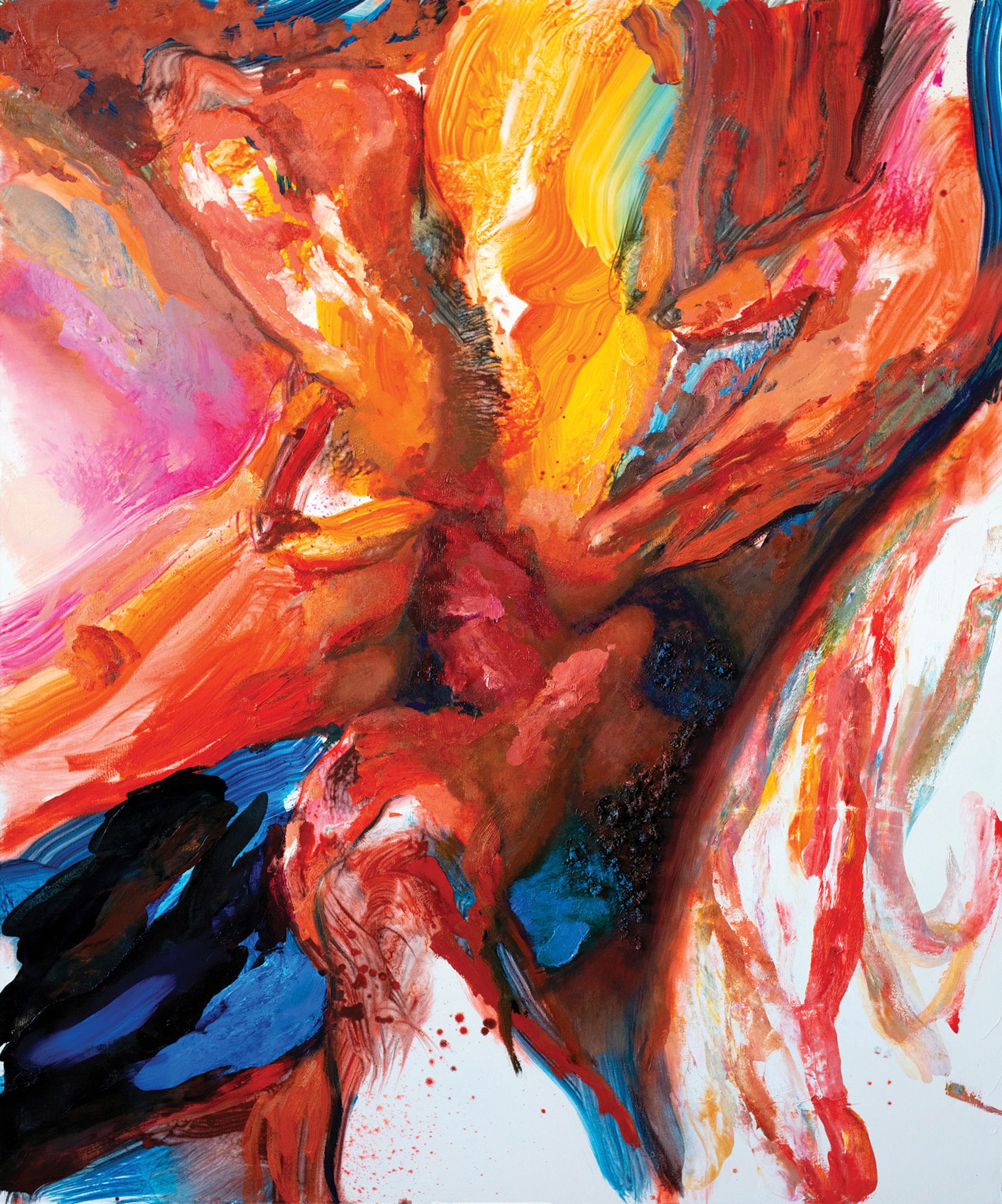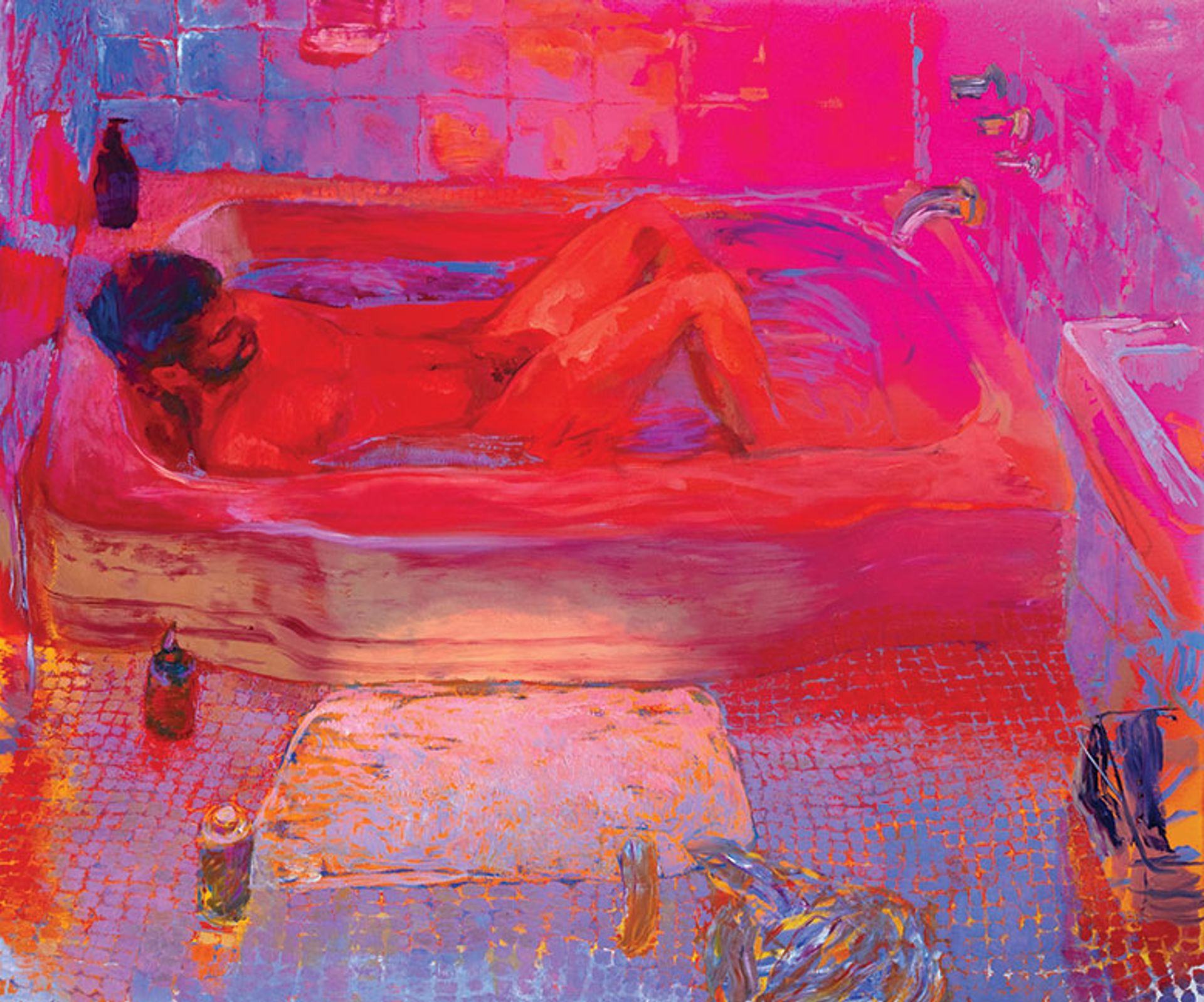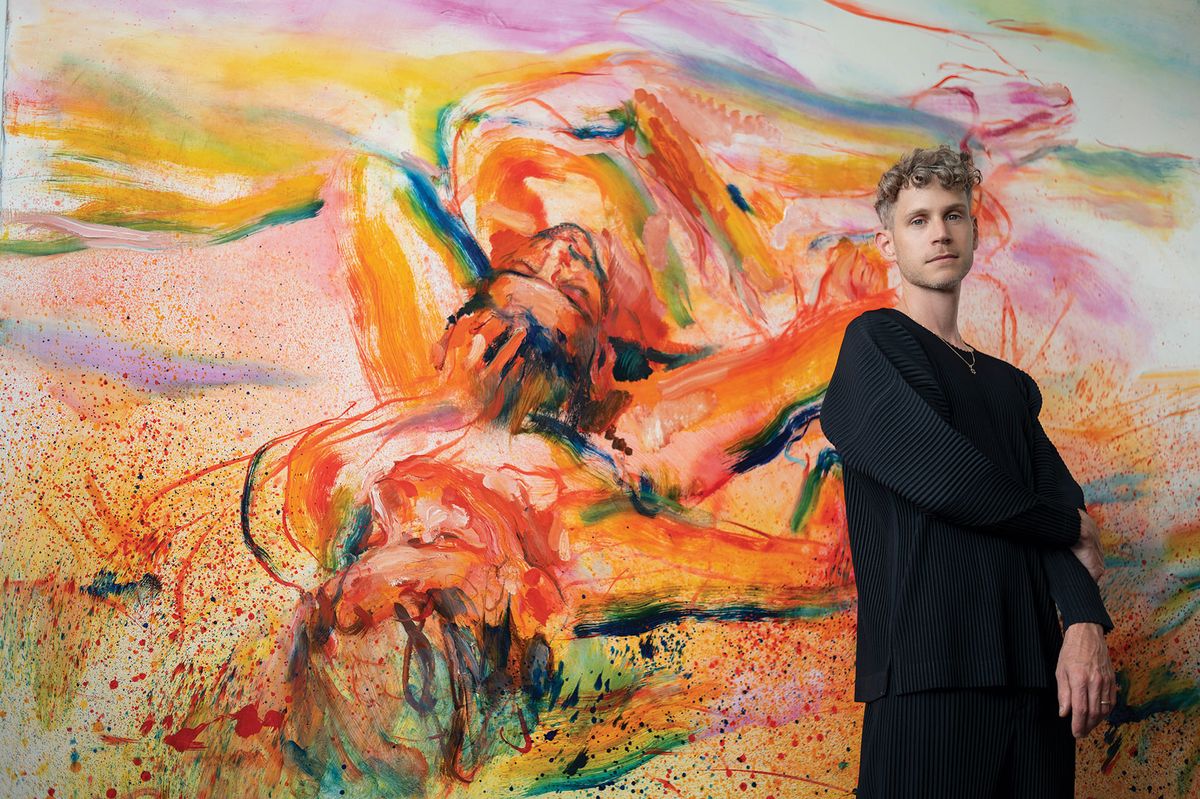Doron Langberg is one of a new generation of figurative painters making a big impact on the international art scene. Based in Brooklyn, Langberg makes paintings that reflect directly and emotionally on the world around him. He is best known for his tender paintings of queer eroticism: often tightly cropped views of friends in the act of having sex. But he hopes to capture what he describes as “a queer subjectivity” that permeates all his work, not just the intimate scenes of his life with his husband, but those picturing him with his siblings in his Israeli homeland. Those landscapes also reflect on the tragic recent death of his sister and “mourning and grief and loss in relationship to this idea of home”, he says. But whether they depict figures, interiors or landscapes, his works make clear references to the history of painting, unapologetically quoting great works by Pierre Bonnard and Edvard Munch, among others.
The Art Newspaper: This is your first solo show in London. How conscious are you that it needs to be a manifesto for your work, or that it has to have a certain quality to it that defines what you do?
Doron Langberg: This is my third solo show. And I feel like, for the first time, this process really felt like the pieces are fully communicating with one another. And it feels like a body of work that is not just a collection of what I’ve done in the last year, but really a more coherent thought. So that was an exciting process to go through in the last year.
The paintings in the show are broad-ranging. They include landscapes, an image of your husband in the bath and very close-up sexual scenes. What do those distinctive characters bring to your work?
Throughout my practice, the sexual content has been a constant, maybe in the core of my practice, and something that, subject matter-wise, relates most to queerness. I think that as my practice grew, I really was thinking about how queer subjectivity can talk about different subject matter, how it could address family, address spaces like home, ideas about mortality, ideas about relationships, love. So, trying to bring very different subject matter together through maybe paint handling or colour, and have a sense of empathy through the touch of the work, that connects it all.

Friends 2 (2021) is one of Langberg’s works which is so closely focused, with such as vivid palette, that it becomes abstracted © Doron Langberg; courtesy of the artist and Victoria Miro
They are really tender portraits: you looking at your husband in your bath in Bather (2021); the two of you in In My Lap (2021), a very gentle, lightly painted image.
The last painting of the show, which is the two of us together, is very lightly painted, like you said, and for years, I wanted to make a painting that feels so lightly touched. It came together in maybe two or three painting sessions. So for me, it was this revelation, almost like a gift, in the end of this painting process. The empathic relationship in the work really comes from my close relationship to the subject matter: so, obviously, with my husband or painting my home or my siblings, and I think it’s this digging inwards that allows people to access these feelings that they also have. That’s perhaps how it operates from a viewer perspective, or what I would project it does.
Do you equivocate that painterly touch to the touch of a body? Are you trying to caress the canvas in the way that you caress a body?
Absolutely. I think that the imprint of my body and having marks that are really fast, really broad, and marks that are smaller, or lightly touched, a variety of textures and gestures in the work, speak to my body and the process of making, like you’re saying. And I think that brings the viewer so much closer to the process, having that so evident on the surface.
You’re engaging with the history of painting and genre—the nude, the landscape, etc. You’ve said that it’s not necessarily the imagery in your work that makes it radical or in some way political or social, but the context in which the work is shown or the political environment in which it is shown.
The politics of the work is really something that I’ve been thinking about for a long time, because I think that my initial impulse, loving people like Lucian Freud growing up, or Avigdor Arikha, is that personal connection, that the painting as an object serves as almost a conduit between the viewer and myself. When I approached to do that, even when I was a student and undergrad, these images were of queer relationships, queer sexual relationships. So the politics was almost presented as something that I had to grapple with in the aftermath of this very straightforward, painterly impulse of sharing something that’s very intimate to me. It took me a long time to understand in terms of the queer politics, how it engages within the work, how it operates. What does it mean to make paintings that represent queer relationships, how a painting of my siblings could be part of a queer narrative or a conversation about queerness? So it’s been really interesting to follow my desires and follow my impulses and see how the politics develops within the work.
You zoom in and out of focus within the body of the work. So there are finely painted elements, closely realised depictions of faces and parts of bodies and landscape. But then there are distinct moments in the canvas where it feels like abstraction. How do you achieve that push-and-pull, and is it a struggle?
I don’t really see the work as having abstract components per se, it’s more abstracted, so they’re all part of a coherent idea of an image or a space, it’s just that some parts are more realised than others. I think it just allows the viewers to move through the piece more freely and allows me to emphasise different elements that I feel are important for the emotional resonance of the work. And what I love about painting is there is such an excitement of letting something dissolve and then refinding it and have it be this fluid process that’s communicated through paint.

Bather (2021) a painting of his husband, references the series of paintings by Pierre Bonnard of his wife, Marthe © Doron Langberg; Courtesy of the artist and Victoria Miro
Your painting Bather is a clear reference to Bonnard’s great series of nudes in the bath. Why did you look at Bonnard?
This show [in London] in general states my references maybe more clearly: the Bonnard, of course; the big landscapes of my siblings to me resonate with Munch landscapes; the cypresses bring up Van Gogh. So I really wanted my personal art history to be on the surface in this show. And Bonnard I’ve been obsessed with since I was an undergrad. To me, the colour, the intimacy, the sense of the closeness of his figures to him as a person comes through so strongly in the work and that’s something that I really desire in my own work.
Is there also something of a challenge in taking on a work like that? They’re so strange, those nudes in the bath; the richness but also the variety of colours in those paintings is really remarkable. So tell us about grappling with that.
This is not the first time that I’ve quoted Bonnard directly, or tried to take his palette. I think what’s masterful about him is that he really uses every colour in every painting and trying to balance this rainbow palette is really almost impossible—or was impossible for me. In [Bather], the reference is less to the colour palette, it’s more in the subject matter of the composition and it’s almost directly relating to the Marthe bath paintings [Marthe was Bonnard’s wife, who spent much of her time in the bath for hydrotherapy]. So in this one I wanted to combine my colour sensibility with something that is so clearly his.
You are addressing queerness in the work while also referencing an art-historical past that is dominated by heterosexual white men. Is there a direct idea of queering that history in addressing it?
To me, what’s important is understanding the ways in which heterosexuality is tied to those works because I think that so much of it is taken for granted. If you think of so many artists—Degas, Picasso, Delacroix, Courbet or Ingres—the nature of their desire really dictates a lot of the choices that they make. And realising that as an artist, I’m thinking about how my desire leads me in different ways and insisting on a certain specificity, especially with the more explicit paintings in the show. I’m also thinking about them as having the power to represent and stand for the many things that straight desire has stood for over time. More than queering a certain canon, it’s more understanding how desire in general operates within these paintings that we almost don’t see.
Why are you a painter? Why do you feel that paint is the best vehicle for telling us about your world?
I started painting when I was six years old. So I feel like it was never an intellectual choice between this or that medium. But when I experienced painting—again, thinking about someone like Lucian Freud, or Arikha, [my] very early childhood experience of seeing them—it was such an impactful, powerful experience, I immediately knew that that’s what I wanted to do. Painting has such an ability to communicate emotionally and empathically in a way that just resonated with me since I can remember. And I still have that relationship to painting: standing in front of a Velázquez is standing in front of a person, that’s not standing in front of a painting. For an object to be able to do that and communicate the full complexity of what it means to be a person is just infinitely compelling to me.
There are arguments that, at the moment, there’s an energy about painting that seems really powerful. Is that your perception, as a painter?
I feel like painting for me has always had that. When I graduated from grad school, which was maybe ten years ago, the dominant mode of working was more related to process-based abstraction. And that has definitely shifted a lot, obviously towards figuration. A lot of us were working figuratively, working in our own little pockets and isolation. I feel like now there have been so many connections drawn between my work and the works of my peers. And that, to me, is extremely exciting. But, as a painter, my relationship to painting has always been like that. So it’s hard for me to see it from the outside, maybe.
Biography
Born: 1985 Yokneam Moshava, Israel
Lives: New York
Education: 2012 MFA, Yale University, New Haven, Connecticut 2010 BFA, University of Pennsylvania, Philadelphia, Key shows: 2021 Schwules Museum, Berlin; RISD Museum, Providence, Rhode Island; 2020 Public Art Fund, New York; LSU Museum of Art, Baton Rouge; 2019 BRIC, Brooklyn; 2018 George Segal Gallery, Montclair State University, New Jersey; 2017 Leslie Lohman Museum, New York; 2016 Green Gallery at Yale University; 2012 Museum of New Art, Detroit
Represented by: Victoria Miro, London
• Doron Langberg: Give Me Love, Victoria Miro, London, until 6 November; Any distance between us, RISD Museum, Providence, Rhode Island, until 13 March 2022; A Place for Me: Figurative Painting Now, Institute of Contemporary Art, Boston, 30 March- 5 September 2022


